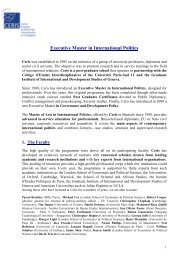hydropolitics of the tigris - euphrates river basin with - ceris.be
hydropolitics of the tigris - euphrates river basin with - ceris.be
hydropolitics of the tigris - euphrates river basin with - ceris.be
Create successful ePaper yourself
Turn your PDF publications into a flip-book with our unique Google optimized e-Paper software.
Tharthar and <strong>the</strong> linking system <strong>of</strong> canals from which water could <strong>be</strong> shifted from <strong>the</strong> Tigris to <strong>the</strong> Euphrates<br />
River <strong>basin</strong>. Due to poor land management and a weak delivery structure (many canals were leaking<br />
heavily), irrigated lands were <strong>be</strong>coming more quickly saline and water-logged. Ra<strong>the</strong>r than improving<br />
irrigation management <strong>the</strong> authorities, by habit, expanded <strong>the</strong> irrigation zones <strong>with</strong> <strong>the</strong> corresponding dams<br />
and barrages. In <strong>the</strong> long-term this policy had limited success, <strong>with</strong> <strong>the</strong> total <strong>of</strong> effective irrigated land area<br />
not really increasing. Consequently production did not kept pace <strong>with</strong> <strong>the</strong> country’s needs, <strong>with</strong> some areas<br />
going out <strong>of</strong> production almost as fast as new areas are initiated. 36<br />
The last major attempt to solve <strong>the</strong> problem <strong>of</strong> salination <strong>with</strong> hydrological structures was <strong>the</strong> construction<br />
<strong>of</strong> <strong>the</strong> Third River which is in fact a canal running from Baghdad to Basra. The Canal was designed to<br />
provide drainage for <strong>the</strong> lands <strong>be</strong>tween <strong>the</strong> two major <strong>river</strong>s and freeing up previously unusable agricultural<br />
land. Started in <strong>the</strong> 1950’s and finished in 1992, <strong>the</strong> canal was originally planned by Western engineers<br />
(British engineer Fred Haigh), supported by Western aid and built by Western contractors. The perception <strong>of</strong><br />
this construction changed after <strong>the</strong> Gulf War <strong>of</strong> 1992. With <strong>the</strong> onset <strong>of</strong> sanctions, many contractors and all<br />
Western funding were pulled out <strong>of</strong> Iraq, who <strong>the</strong>n finished <strong>the</strong> project <strong>the</strong>mselves at a cost <strong>of</strong> $ 2 billion<br />
(USD). 37 There were, however, some changes to <strong>the</strong> original design.<br />
The Third River has also <strong>be</strong>en credited <strong>with</strong> <strong>be</strong>ing <strong>the</strong> means <strong>of</strong> draining <strong>the</strong> waters <strong>of</strong> <strong>the</strong> famous reed<br />
marshes <strong>of</strong> sou<strong>the</strong>rn Iraq, which were also home to many Shi’ite dissidents who re<strong>be</strong>lled against Saddam<br />
Hussein after <strong>the</strong> Gulf War. During <strong>the</strong> 1970’s and <strong>the</strong> 1980’s <strong>the</strong> focus <strong>of</strong> <strong>the</strong> construction <strong>of</strong> <strong>the</strong> Third<br />
River <strong>be</strong>gan to shift from <strong>be</strong>ing merely a drainage system to also include a system <strong>of</strong> marshland drainage<br />
and reclamation. The main changes introduced by <strong>the</strong> Iraqi Government included <strong>the</strong> installation <strong>of</strong> dams<br />
and diversions along <strong>the</strong> Tigris and Euphrates that served to divert flow around <strong>the</strong> Marshes ei<strong>the</strong>r straight<br />
into <strong>the</strong> Gulf or into <strong>the</strong> Shatt Al-Arab. Following <strong>the</strong> civil unrest in <strong>the</strong> south, <strong>the</strong> government worked<br />
intensively for 9 months to construct <strong>the</strong> diversions. The original drainage system works effectively in<br />
evacuating saline return flow and could conceivably improve water quality in <strong>the</strong> Marshlands. However by<br />
effectively blocking any inflow to <strong>the</strong> Marshes, <strong>the</strong>ir destruction was inevitable. 38<br />
This has had serious consequences for Iraq <strong>be</strong>cause, like Syria, it was originally an agricultural economy<br />
capable <strong>of</strong> sustaining itself in terms <strong>of</strong> food security. As <strong>with</strong> Syria this situation changed rapidly and<br />
agriculture dropped from 70% <strong>of</strong> Iraq’s GDP in <strong>the</strong> 1920’s to as low as 6% in 2001. A part <strong>of</strong> this GDP<br />
18





